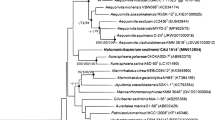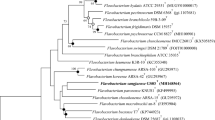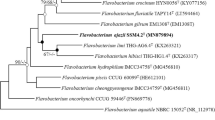Abstract
A novel bright-yellow pigmented bacterial strain SM2-FT was isolated from a mangrove sediment collected at the mangrove coast of Luoyang estuary, Quanzhou, China. Strain SM2-FT was Gram-stain-negative, catalase-weak positive, oxidase-positive, rod-shaped, non-flagellated and non-motile. Growth of strain SM2-FT was observed at 20–40 °C (optimum, 30 °C), pH 6.0–8.0 (optimum, pH 7.0) and in the presence of 1.0–4.0% NaCl (optimum, 2.0% NaCl). Flexirubin-pigment was absent, and carotenoid-pigment was present. Phylogenetic analysis of 16S rRNA gene sequence placed strain SM2-FT into the family Flavobacteriaceae and shared the maximum sequence similarity with Aequorivita soesokkakensis RSSK-12 T of 92.5%. Whole genomic comparison between strain SM2-FT and close relatives suggested a novel species of a novel genus. The predominant quinone of strain SM2-FT was menaquinone (MK)-6. The major fatty acids (> 10%) comprised iso-C15:1 G (32.4%) and iso-C15:0 (29.1%). The polar lipid profile consisted of phosphatidylethanolamine, two unidentified aminolipids and four unidentified lipids. The complete genome size was 4,094,245 bp with DNA G + C content of 36.0 mol%. Based on the data of polyphasic study, strain SM2-FT was considered to represent a novel species of a novel genus, for which the name Aegicerativicinus sediminis gen. nov., sp. nov., was proposed. The type strain was SM2-FT (= MCCC 1K04383T = KCTC 82361 T).

Similar content being viewed by others
Data availability
The GenBank/EMBL/DDBJ accession numbers of the 16S rRNA gene sequence and complete genome sequence of strain SM2-FT are MT829543 and CP064295, respectively.
Abbreviations
- MCCC:
-
Marine culture collection of China
- KCTC:
-
Korean collection for type cultures
- dDDH:
-
Digital DNA-DNA hybridization
- ANI:
-
Average nucleotide identity
- POCP:
-
Percentage of conserved proteins
- ML:
-
Maximum-likelihood
- NJ:
-
Neighbor-joining
- BIC:
-
Bayesian information CRITERION
References
Bankevich A, Nurk S, Antipov D, Gurevich AA, Dvorkin M, Kulikov AS et al (2012) SPAdes: a new genome assembly algorithm and its applications to single-cell sequencing. J Comput Biol 19(5):455–477. https://doi.org/10.1089/cmb.2012.0021
Bernardet JF (2015) Flavobacteriaceae. Bergey’s Man Sys Archaea Bacteria. https://doi.org/10.1002/9781118960608.fbm00069
Bernardet JF, Nakagawa Y, Holmes B (2002) Proposed minimal standards for describing new taxa of the family Flavobacteriaceae and emended description of the family. Int J Syst Evol Microbiol 52(Pt 3):1049–1070. https://doi.org/10.1099/00207713-52-3-1049
Blin K, Shaw S, Steinke K, Villebro R, Ziemert N, Lee SY et al (2019) antiSMASH 50 updates to the secondary metabolite genome mining pipeline. Nucleic Acids Res. https://doi.org/10.1093/nar/gkz310
Bowman JP (2017) Aequorivita. Bergey’s Man Sys Archaea Bacteria. https://doi.org/10.1002/9781118960608.gbm00293.pub2
Bowman JP, Nichols DS (2002) Aequorivita gen. nov., a member of the family Flavobacteriaceae isolated from terrestrial and marine Antarctic habitats. Int J Syst Evol Microbiol 52(Pt 5):1533–1541
Chin CS, Alexander DH, Marks P, Klammer AA, Drake J, Heiner C et al (2013) Nonhybrid, finished microbial genome assemblies from long-read SMRT sequencing data. Nat Methods 10(6):563–569. https://doi.org/10.1038/nmeth.2474
Guo J, Sun J, Xu Y, Fang L, Jiao N, Zhang R (2020) Arenibacter aquaticus sp. nov., a marine bacterium isolated from surface sea water in the South China Sea. Int J Syst Evol Microbiol 70(2):958–963
Huang Z, Dong C, Shao Z (2016) Paraphotobacterium marinum gen. nov., sp. nov., a new member of the family Vibrionaceae, isolated from the surface seawater of the South China Sea. Int J Syst Evol Microbiol 66:3050–3056. https://doi.org/10.1099/ijsem.0.001142
Hyatt D, Chen GL, Locascio PF, Land ML, Larimer FW, Hauser LJ (2010) Prodigal: prokaryotic gene recognition and translation initiation site identification. BMC Bioinformatics 11:119. https://doi.org/10.1186/1471-2105-11-119
Ivanova EP, Nedashkovskaya OI, Chun J, Lysenko AM, Frolova GM, Svetashev VI et al (2001) Arenibacter gen. nov., new genus of the family flavobacteriaceae and description of a new species Arenibacter latericius sp. nov.,. Int J Syst Evol Microbiol 51(Pt 6):1987–1995
Jooste PJ, Hugo CJ (1999) The taxonomy, ecology and cultivation of bacterial genera belonging to the family Flavobacteriaceae. Int J Food Microbiol 53(2–3):81–94. https://doi.org/10.1016/S0168-1605(99)00162-2
Komagata K, Suzuki K (1987) Lipid and cell-wall analysis in bacterial systematics. Methods Microbiol 19:161–207. https://doi.org/10.1016/S0580-9517(08)70410-0
Kumar S, Stecher G, Tamura K (2016) MEGA7: molecular evolutionary genetics analysis version 7.0 for bigger datasets. Mol Biol Evol. https://doi.org/10.1093/molbev/msw054
Lagesen K, Hallin P, Rodland EA, Staerfeldt HH, Rognes T, Ussery DW (2007) RNAmmer: consistent and rapid annotation of ribosomal RNA genes. Nucleic Acids Res 35(9):3100–3108. https://doi.org/10.1093/nar/gkm160
Lee I, Kim YO, Park SC, Chun J (2015) OrthoANI: an improved algorithm and software for calculating average nucleotide identity. Int J Syst Evol Microbiol 66:1100–1103. https://doi.org/10.1099/ijsem.0.000760
Liu JJ, Zhang XQ, Pan J, Sun C, Zhang Y, Li CQ et al (2013) Aequorivita viscosa sp. nov., isolated from an intertidal zone, and emended descriptions of Aequorivita antarctica and Aequorivita capsosiphonis. Int J Syst Evol Microbiol. https://doi.org/10.1099/ijs.0.049635-0
Nedashkovskaya OI (2018) Arenibacter. Bergey’s Man Sys Archaea and Bacteria. https://doi.org/10.1002/9781118960608.gbm00296.pub2
Park S, Lee KC, Bae KS, Yoon JH (2014) Vitellibacter soesokkakensis sp. nov., isolated from the junction between the ocean and a freshwater spring and emended description of the genus Vitellibacter. Int J Syst Evol Microbiol 64(Pt 2):588–593
Parte AC, Sarda Carbasse J, Meier-Kolthoff JP, Reimer LC, Goker M (2020) List of Prokaryotic names with Standing in Nomenclature (LPSN) moves to the DSMZ. Int J Syst Evol Microbiol 70(11):5607–5612. https://doi.org/10.1099/ijsem.0.004332
Qin QL, Xie BB, Zhang XY, Chen XL, Zhou BC, Zhou J et al (2014) A proposed genus boundary for the prokaryotes based on genomic insights. J Bacteriol 196(12):2210–2215. https://doi.org/10.1128/JB.01688-14
Quast C, Pruesse E, Yilmaz P, Gerken J, Schweer T, Yarza P et al (2013) The SILVA ribosomal RNA gene database: project improved data processing and web-based tools. Nucl Acid Res. https://doi.org/10.1093/nar/gks1219
Williams TJ, Wilkins D, Long E, Evans F, DeMaere MZ, Raftery MJ et al (2013) The role of planktonic flavobacteria in processing algal organic matter in coastal East Antarctica revealed using metagenomics and metaproteomics. Environ Microbiol 15(5):1302–1317. https://doi.org/10.1111/1462-2920.12017
Yarza P, Yilmaz P, Pruesse E, Glockner FO, Ludwig W, Schleifer KH et al (2014) Uniting the classification of cultured and uncultured bacteria and archaea using 16S rRNA gene sequences. Nat Rev Microbiol 12(9):635–645. https://doi.org/10.1038/nrmicro3330
Yoon J, Adachi K, Park S, Kasai H, Yokota A (2011) Aureibacter tunicatorum gen. nov., sp. nov., a marine bacterium isolated from a coral reef sea squirt and description of Flammeovirgaceae fam. nov. Int J Syst Evol Microbiol. https://doi.org/10.1099/ijs.0.027573-0
Yoon J, Adachi K, Kasai H (2016) Aureisphaera salina sp. nov., a member of the family Flavobacteriaceae isolated from an ascidian. Int J Syst Evol Microbiol. https://doi.org/10.1099/ijsem.0.001132
Yoon SH, Ha SM, Kwon S, Lim J, Kim Y, Seo H et al (2016b) Introducing EzBioCloud: a taxonomically united database of 16S rRNA and whole genome assemblies. Int J Syst Evol Microbiol. https://doi.org/10.1099/ijsem.0.001755
Yoon SH, Ha SM, Lim J, Kwon S, Chun J (2017) A large-scale evaluation of algorithms to calculate average nucleotide identity. Antonie Van Leeuwenhoek 110(10):1281–1286. https://doi.org/10.1007/s10482-017-0844-4
Acknowledgements
The authors would like to thank Prof. Aharon Oren (The Hebrew University of Jerusalem, Israel) for his advice on naming the new species.
Funding
This work was supported by the project of National Science Foundation of Fujian Province (2020J01789) and National Infrastructure of Natural Resources for Science and Technology Program of China (NIMR-2020–9).
Author information
Authors and Affiliations
Contributions
ZH and QL conceived the study and drafted the manuscript. ZH, YG, QL, XL, and QX performed the experiment and analyze the data.
Corresponding authors
Ethics declarations
Conflict of interest
The authors declare that they have no conflict of interest.
Ethics approval
This article does not contain any studies with animals.
Consent for publication
The authors approved for the publication.
Additional information
Publisher's Note
Springer Nature remains neutral with regard to jurisdictional claims in published maps and institutional affiliations.
Supplementary Information
Below is the link to the electronic supplementary material.
Rights and permissions
About this article
Cite this article
Huang, Z., Guo, Y., Xiao, Q. et al. Aegicerativicinus sediminis gen. nov., sp. nov., a novel carotenoid-producing marine bacterium in the family Flavobacteriaceae. Antonie van Leeuwenhoek 114, 1551–1563 (2021). https://doi.org/10.1007/s10482-021-01621-8
Received:
Accepted:
Published:
Issue Date:
DOI: https://doi.org/10.1007/s10482-021-01621-8




